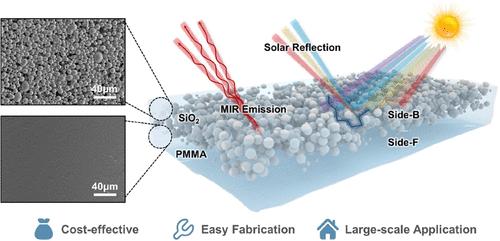Auto-Deposited Microparticle Composite Coating for Low-Cost and Efficient Daytime Radiative Cooling
IF 8.2
2区 材料科学
Q1 MATERIALS SCIENCE, MULTIDISCIPLINARY
引用次数: 0
Abstract
Radiative cooling is an excellent strategy for mitigating global warming, by enhancing heat fluxes away from the Earth, thus balancing the Earth’s heat flow. However, for randomly particle-dispersed radiative cooling materials, the particle content as high as 94–96 wt % or 60 vol %, far exceeds the critical pigment percentage (40–50%) of traditional coatings, preventing its large-scale application. Here, inspired by particle deposition under gravity in solution, we demonstrate an auto-deposited SiO2 composite radiative cooling coating (ADRC) which reduces the amounts of particles required and lowers costs. This particle density gradient structure enhances the local volume fraction of particles, thereby the coating exhibits high solar reflectance (93%) and infrared emissivity (89%), contributing to a daytime subambient temperature drop of 12 °C. The cooling energy-saving potential of buildings in China utilizing the ADRC as roofs ranges from 6.42 to 13.52%. This low-cost and scalable radiative cooler is expected to reduce energy consumption and carbon emissions, addressing global warming issues.

用于低成本高效日间辐射冷却的自动沉积微粒复合涂层
辐射冷却是缓解全球变暖的一种极好的策略,它通过增强远离地球的热流,从而平衡地球的热流。然而,对于随机颗粒分散的辐射冷却材料,颗粒含量高达94-96 wt %或60 vol %,远远超过了传统涂料的临界颜料百分比(40-50%),阻碍了其大规模应用。在这里,受重力作用下粒子沉积的启发,我们展示了一种自动沉积SiO2复合辐射冷却涂层(ADRC),它减少了所需粒子的数量并降低了成本。这种颗粒密度梯度结构提高了颗粒的局部体积分数,因此涂层具有较高的太阳反射率(93%)和红外发射率(89%),有助于白天亚环境温度下降12°C。在中国,使用ADRC作为屋顶的建筑的冷却节能潜力在6.42 ~ 13.52%之间。这种低成本和可扩展的辐射冷却器有望减少能源消耗和碳排放,解决全球变暖问题。
本文章由计算机程序翻译,如有差异,请以英文原文为准。
求助全文
约1分钟内获得全文
求助全文
来源期刊

ACS Applied Materials & Interfaces
工程技术-材料科学:综合
CiteScore
16.00
自引率
6.30%
发文量
4978
审稿时长
1.8 months
期刊介绍:
ACS Applied Materials & Interfaces is a leading interdisciplinary journal that brings together chemists, engineers, physicists, and biologists to explore the development and utilization of newly-discovered materials and interfacial processes for specific applications. Our journal has experienced remarkable growth since its establishment in 2009, both in terms of the number of articles published and the impact of the research showcased. We are proud to foster a truly global community, with the majority of published articles originating from outside the United States, reflecting the rapid growth of applied research worldwide.
文献相关原料
公司名称
产品信息
阿拉丁
Ethanol (95%)
阿拉丁
Aqueous ammonia
阿拉丁
Tetraethyl orthosilicate (TEOS)
阿拉丁
Silica (SiO2)
阿拉丁
N, N-dimethylformamide (DMF)
阿拉丁
Poly(vinyl alcohol) (PVA)
阿拉丁
Poly(methyl methacrylate) (PMMA)
 求助内容:
求助内容: 应助结果提醒方式:
应助结果提醒方式:


